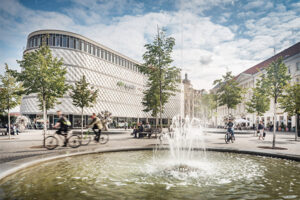The Covid-19 pandemic has left hardly any business or industry in Poland untouched and retail real estate industry has also been affected. The last twelve months were marked by three lockdowns that helped change the shopping habits of Poles, lower developer activity, and increase the popularity of smaller retail formats.
According to JLL’s “Polish Retail Market” report from January 2021 the local and convenience trend, which existed before Covid-19, has been boosted by the pandemic, and is reflected in the new retail supply. In 2020, developers in Poland completed 430,000 sq m of modern retail space both in large-scale projects (GLA > 5,000 sq m)
and convenience centers (GLA of between 2,000 sq m and 4,999 sq m). Of the new space delivered in 2020 41% was located in retail parks and another 28% in convenience centers. Shopping centers, which are still the most widespread format on the market, delivered a mere of 86,000 sq m (20% of the new retail space).
335,000 sq m withdrawn from stock
The largest retail schemes opened in Poland in 2020 included the following shopping centers: Galeria Wiślanka in Żory (20,000 sq m of GLA), Dekada in Nysa (19,600 sq m of GLA), and Galeria Chełm in Chełm (17,500 sq m of GLA). In addition, Elektrownia Powiśle mixed-use project was opened in Warsaw (15,500 sq m of GLA). At the same time, however, approximately 335,000 sq m was withdrawn from the stock, due to several closures of older assets of Tesco and Auchan, the Sukcesja shopping center in Łódź, and
a few conversions of retail space into other functions.
As a result, the total modern retail stock in Poland, covering large scale formats and convenience centers, stood at a total of 15.9 million sq m of GLA at the end of 2020. 414
shopping centers account for 9.97 million sq m of that space, which equates to a shopping center density of 260 sq m/ 1,000 people. In line with growing market maturity, developer activity is slowing down. Approximately 406,000 sq m of GLA was under construction at the year’s end, confirming this trend. Retail parks and standalone
retail warehouses account for the largest shares in the under-construction retail space (36% and 30%, accordingly).
As predicted, the pandemic has already led to growth in vacancy rates all over Poland. According to the market survey, the average in the eight major metropolitan areas increased from 4.4% in H2 2019 to 5.3% in August 2020. Along with the government restrictions placed on shopping centers, the share of e-commerce has been fluctuating over the last few months, reaching a peak of 11.9% in total retail sales in April 2020, when the most severe lockdown was in force. Although e-commerce is now very much developing in Poland, traditional retailing is still the first choice for most consumers.
Seeking alternative location types
Nevertheless, the pandemic has highlighted the challenges that the market has been facing for a long time. It is not only about the need to increase the activity of retail chains in e-commerce and omni-channel, but also about seeking out alternative location
types that will allow brands to attract new target groups. This includes, but is not limited to, retail units on ground floors of residential premises and high street locations.
Most retailers are scrambling to adapt to new market conditions and shifts in ways customers shop. They know the situation is changing daily and their responses are required immediately. The drop in footfall numbers in the majority of shopping centers
combined with a drop in turnover, as well as negotiations between tenants and landlords, have caused a slowdown, and temporary suspension of development plans. However, as far as the withdrawal of some retail chains from the Polish market is concerned, the decisions were taken based on overall global situation of these brands and were not only specific to the Polish market. Among the firms that decided to close their operations in Poland were: fashion chains Forever21, Camaieu, Promod, and Stefanel, shoe chain Salamander, sports goods provider Sportisimo, and household goods chain Miniso. In most cases, however, these retail chains had faced financial problems long before the pandemic, which only accelerated their final decisions. The entertainment and F&B sectors are in a particularly difficult situation, too. Value retailers and grocery chains were the least affected by the pandemic and their expansion plans have hardly changed.
Despite uncertain future, a number of international retailers decided to open their first stores in Poland in 2020. These include, among others: fashion giants Primark, from Ireland, and Urban Outfitters, from the USA.
The good news is that JLL’s experts report that, despite lack of any transactional evidence in the shopping centersector, the markets expect prime shopping center yields to contract to the level of 5.25%, driven entirely by sentiment. Prime retail park yields remain at the level of 6.8% and are expected to compress, due to increased investor demand for that type of product.





